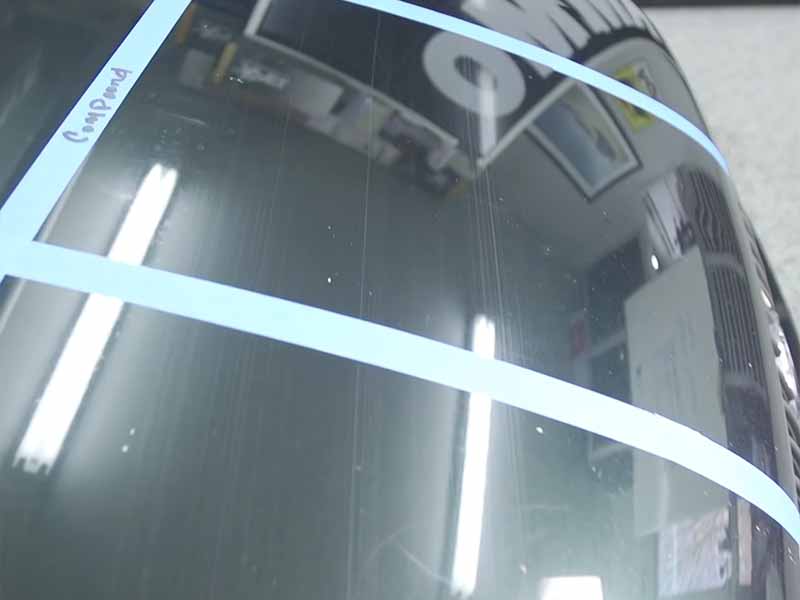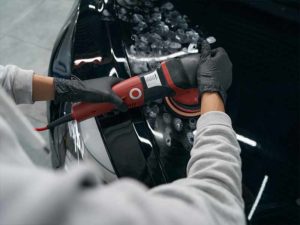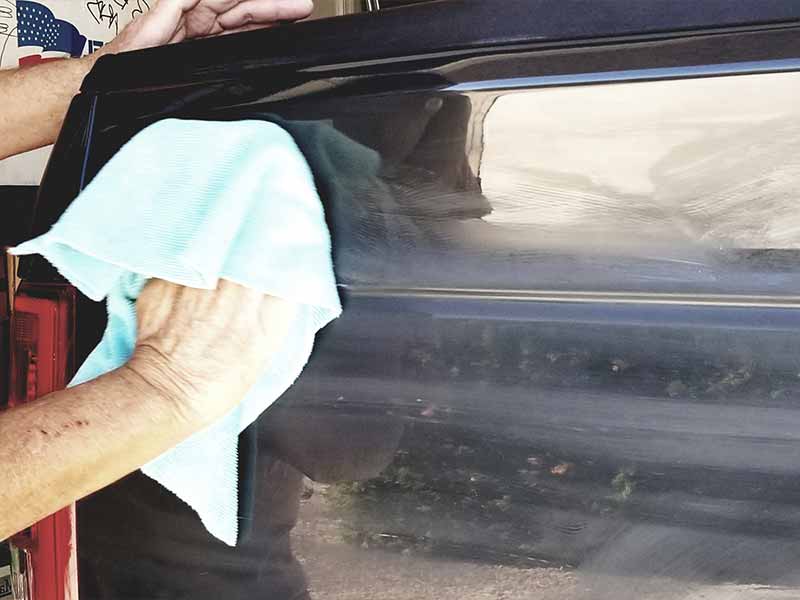Table of Contents
Even when doing your best to follow proper car maintenance, park your car or truck in a garage, and protect it from everyday wear and tear, damage can happen to your clear coat over time.
Rubbing compound does a great job of removing stubborn stains, light scratches, and oxidation when restoring old paintwork. The grit of such a compound is aggressive enough to quickly remove these defects, but it leaves a slightly dull finish.
What To Use After Rubbing Compound
To remove any dull haze left on the clear coat of your paintwork from using rubbing compound, you’ll need to use a quality polish. Car polishes have a finer grit than rubbing compounds and will restore the finish to a like-new shine.
Once you’re satisfied that you’re restored the glossy finish, it’s smart to apply a protective layer of wax, paint sealant, or ceramic coating to protect the surface from future damage.
Rubbing compound isn’t meant to be the only step in restoring your clear coat to a pristine finish. It’s just one component to the paint correction process. You’ll need to restore the shine that applying rubbing compound dulls.
Rubbing Compound Before and After
In this video, Larry thoroughly explains the use of polishing compounds, rubbing compounds, and wet sanding. He addresses the need to polish after using rubbing compound and the light haze that is left behind before a polish is used.
Rubbing Compound Before
Here is a look at a vehicle before applying rubbing compound. You can see the scratches and chips in the paint that need to be addressed. The rubbing compound will clear up these flaws.

Rubbing Compound After
Here, after applying rubbing compound on the surface paintwork and working on the heavy scratches, you can see there is a very serious haze, and the paint looks incredibly dull. So, this photo shows that rubbing compound dulls the car paint in some instances and requires additional steps to restore shine.
Rubbing Compound Haze
You have probably heard about the infamous haze left behind after you use rubbing compound on your vehicle to bring the paint back to life. While rubbing compound is a great product, the dull haze that is left behind is not.
More often than not, the haze is a result of too much product being used or being applied incorrectly. Incorrect application can include using a dirty applicator pad or microfiber cloth or failing to thoroughly wash and dry the vehicle beforehand.
Rubbing Compound Left a Dull Spot
It is not at all uncommon for the rubbing compound to leave behind a dull, hazy appearance on your car. When this happens, you don’t want to go back over it with even more rubbing compound. More than likely, an excess amount of rubbing compound is what caused this problem.
In order to remove it, you need to follow your rubbing compound treatment with a polish and/or wax. This will restore shine that has been lost.
How to Remove
Rubbing Compound Haze
No one wants rubbing compound haze on their vehicle. The good news is there are several ways to remove it.
- Buffing Pad – If you know that you used too much rubbing compound and that’s what caused the haze, then you can buff it out. Keep in mind this will take some time and elbow grease on your part, but the haze should come off. Don’t buff if you believe the haze is a result of dust and dirt particles, as this will scratch up your paint, and always use a circular motion and a clean rag. If using an orbital buffer, make sure to move in small circles.
- Soap and Water – As long as the rubbing compound hasn’t completely settled into the surface of the car, you can use plain old soap and water to wash some of that rubbing compound off, along with the haze. Just understand that you may need to re-apply it to get the finish you are looking for.
- Alcohol and Water Mixture – Rubbing alcohol is good for so many things, including helping to remove rubbing compound haze. However, it should never be used at full strength, or it may eat right through your paintwork. Create a mixture of alcohol and water, lightly spray it on the affected surface, and gently rub it. This should only remove the rubbing compound haze and not all of the compound.
- Polish – Polishing is the next step in the process, and it can often remove rubbing compound haze without having to do the aforementioned steps. Plus, polish will restore the shine of your paintwork after the rubbing compound dulls it. You will be left with a like new finish on your car.

Paint Correction Process
Paint correction is the process of removing various imperfections in the car’s finish and restoring it to its original state, sometimes even better. Some examples of these imperfections may include light scratches, wash marring, water spots, etchings from bird droppings, and even oxidation.
Compound
The first part of the paint correction process is compounding. This is where a rubbing compound is applied to the surface of the car. This compound is an abrasive cleaner of sorts and works similar to that of fine grit sandpaper, as it shaves down some of the clear coat when used with a buffer.
Polish
Once the compounding process has been completed (which is where all the heavy lifting occurs), then the polishing stage occurs. Polishing works to remove any haze and swirl marks that may have been left behind from compounding. A polishing compound is used, and it is yet another abrasive cleaner that acts as fine grit sandpaper (more so than the rubbing compound). Polishing helps to refine the “fresh” paintwork to leaven behind a beautifully polished surface.
Wax
Finally, it is time to add a protective layer over the work you have just completed. This is usually done in the form of a non-abrasive wax. The wax will help restore shine that was lost during the paint correction process while also protecting the surface from tree sap, animal waste, industrial fall out, acid rain, and more. To add even more protection, you may want to add a paint sealant and then a wax.

Frequently Asked Questions
How Do You Clean Off Rubbing Compound?
If some of the rubbing compound dries on your vehicle and you need to get it off, the process is relatively simple. Wet a soft towel and rub over the compound to re-wet it. If necessary, you can also use a soft-bristled toothbrush to loosen the compound, but make sure you don’t apply too much pressure. Wipe away left-behind residue with a dry and clean microfiber towel.
If some of the compound is still being stubborn, you can use peanut butter, vegetable oil, or a handheld steamer to help soften and remove the compound.
How Do You Get the Shine Back After Using Rubbing Compound?
While the application of a rubbing compound can fix scratches and paint oxidation, it can also leave the surface of the paintwork a bit cloudy and dull-looking. The best way to get the glossy appearance back after you apply rubbing compound is with the application of an even coat of non-abrasive wax. This coat of wax will not only restore the car’s shine, but it will also protect your vehicle against damage in the future. Remember, never apply wax in direct sunlight to avoid the wax drying unevenly and leaving swirl marks behind. Therefore, to prevent wax buildup on your car, perform this task in a shady area.
Do You Need to Polish After Using Compound?
Ideally, yes. Although, you don’t always have to. Both compounding and polishing work to remove scratches and other defects in the paint’s finish. So, after you finish the compounding treatment, take a look at the finish.
If it is dull or hazy, then a polishing compound should be used. If the paintwork looks good with no more imperfections (like haziness or swirl marks), then you can choose to use the polish as a safety and protective measure to further improve the paintwork, or you can choose to simply apply a wax to improve the appearance, restore the shine, and protect the paintwork.
Do You Wax After Polishing Compound?
Yes, it is always a good idea to apply a non-abrasive wax after you have treated your car with a polishing compound. This helps to refine the car’s shine and also add another protective layer against the elements for the paintwork.
Do You Have to Wax After Using Rubbing Compound?
No, you don’t need to use a wax after you apply rubbing compound on your car. Polishing after using rubbing compound will remove the dull haze and restore the shine, but using a wax, paint sealant, or ceramic coating will provide a protective layer that will help prevent the problems that required the use of a rubbing compound in the first place.
Is Rubbing Compound Bad for Car Paint?
No, rubbing compound is completely safe to use on your auto paint and will not cause damage, as long as it is applied correctly. If you failed to completely clean the car surface and there are pieces of abrasive materials on the surface of the car, then it is possible for the rubbing compound to damage the car paint. Remember, the purpose of this product is to conceal imperfections in the paintwork and restore it to its former glory. The only thing you may have to deal with is a dull finish or haze on the surface of the vehicle. However, both of these can easily be fixed with a quality car polish.









